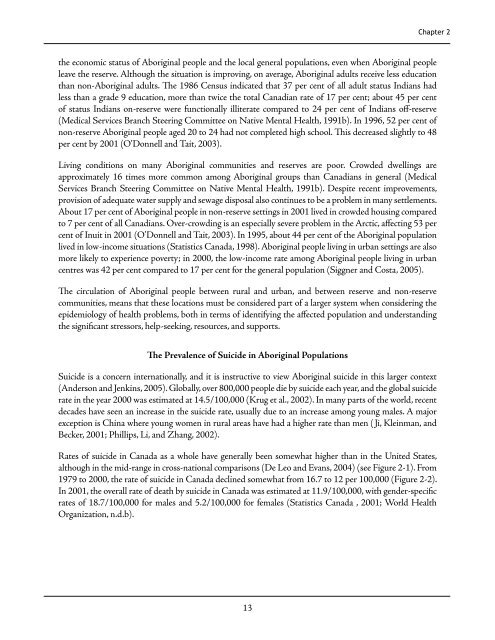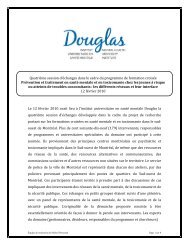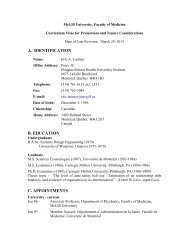Suicide Among Aboriginal People in Canada - Institut universitaire ...
Suicide Among Aboriginal People in Canada - Institut universitaire ...
Suicide Among Aboriginal People in Canada - Institut universitaire ...
Create successful ePaper yourself
Turn your PDF publications into a flip-book with our unique Google optimized e-Paper software.
Chapter 2the economic status of <strong>Aborig<strong>in</strong>al</strong> people and the local general populations, even when <strong>Aborig<strong>in</strong>al</strong> peopleleave the reserve. Although the situation is improv<strong>in</strong>g, on average, <strong>Aborig<strong>in</strong>al</strong> adults receive less educationthan non-<strong>Aborig<strong>in</strong>al</strong> adults. The 1986 Census <strong>in</strong>dicated that 37 per cent of all adult status Indians hadless than a grade 9 education, more than twice the total Canadian rate of 17 per cent; about 45 per centof status Indians on-reserve were functionally illiterate compared to 24 per cent of Indians off-reserve(Medical Services Branch Steer<strong>in</strong>g Committee on Native Mental Health, 1991b). In 1996, 52 per cent ofnon-reserve <strong>Aborig<strong>in</strong>al</strong> people aged 20 to 24 had not completed high school. This decreased slightly to 48per cent by 2001 (O’Donnell and Tait, 2003).Liv<strong>in</strong>g conditions on many <strong>Aborig<strong>in</strong>al</strong> communities and reserves are poor. Crowded dwell<strong>in</strong>gs areapproximately 16 times more common among <strong>Aborig<strong>in</strong>al</strong> groups than Canadians <strong>in</strong> general (MedicalServices Branch Steer<strong>in</strong>g Committee on Native Mental Health, 1991b). Despite recent improvements,provision of adequate water supply and sewage disposal also cont<strong>in</strong>ues to be a problem <strong>in</strong> many settlements.About 17 per cent of <strong>Aborig<strong>in</strong>al</strong> people <strong>in</strong> non-reserve sett<strong>in</strong>gs <strong>in</strong> 2001 lived <strong>in</strong> crowded hous<strong>in</strong>g comparedto 7 per cent of all Canadians. Over-crowd<strong>in</strong>g is an especially severe problem <strong>in</strong> the Arctic, affect<strong>in</strong>g 53 percent of Inuit <strong>in</strong> 2001 (O’Donnell and Tait, 2003). In 1995, about 44 per cent of the <strong>Aborig<strong>in</strong>al</strong> populationlived <strong>in</strong> low-<strong>in</strong>come situations (Statistics <strong>Canada</strong>, 1998). <strong>Aborig<strong>in</strong>al</strong> people liv<strong>in</strong>g <strong>in</strong> urban sett<strong>in</strong>gs are alsomore likely to experience poverty; <strong>in</strong> 2000, the low-<strong>in</strong>come rate among <strong>Aborig<strong>in</strong>al</strong> people liv<strong>in</strong>g <strong>in</strong> urbancentres was 42 per cent compared to 17 per cent for the general population (Siggner and Costa, 2005).The circulation of <strong>Aborig<strong>in</strong>al</strong> people between rural and urban, and between reserve and non-reservecommunities, means that these locations must be considered part of a larger system when consider<strong>in</strong>g theepidemiology of health problems, both <strong>in</strong> terms of identify<strong>in</strong>g the affected population and understand<strong>in</strong>gthe significant stressors, help-seek<strong>in</strong>g, resources, and supports.The Prevalence of <strong>Suicide</strong> <strong>in</strong> <strong>Aborig<strong>in</strong>al</strong> Populations<strong>Suicide</strong> is a concern <strong>in</strong>ternationally, and it is <strong>in</strong>structive to view <strong>Aborig<strong>in</strong>al</strong> suicide <strong>in</strong> this larger context(Anderson and Jenk<strong>in</strong>s, 2005). Globally, over 800,000 people die by suicide each year, and the global suiciderate <strong>in</strong> the year 2000 was estimated at 14.5/100,000 (Krug et al., 2002). In many parts of the world, recentdecades have seen an <strong>in</strong>crease <strong>in</strong> the suicide rate, usually due to an <strong>in</strong>crease among young males. A majorexception is Ch<strong>in</strong>a where young women <strong>in</strong> rural areas have had a higher rate than men ( Ji, Kle<strong>in</strong>man, andBecker, 2001; Phillips, Li, and Zhang, 2002).Rates of suicide <strong>in</strong> <strong>Canada</strong> as a whole have generally been somewhat higher than <strong>in</strong> the United States,although <strong>in</strong> the mid-range <strong>in</strong> cross-national comparisons (De Leo and Evans, 2004) (see Figure 2-1). From1979 to 2000, the rate of suicide <strong>in</strong> <strong>Canada</strong> decl<strong>in</strong>ed somewhat from 16.7 to 12 per 100,000 (Figure 2-2).In 2001, the overall rate of death by suicide <strong>in</strong> <strong>Canada</strong> was estimated at 11.9/100,000, with gender-specificrates of 18.7/100,000 for males and 5.2/100,000 for females (Statistics <strong>Canada</strong> , 2001; World HealthOrganization, n.d.b).13
















